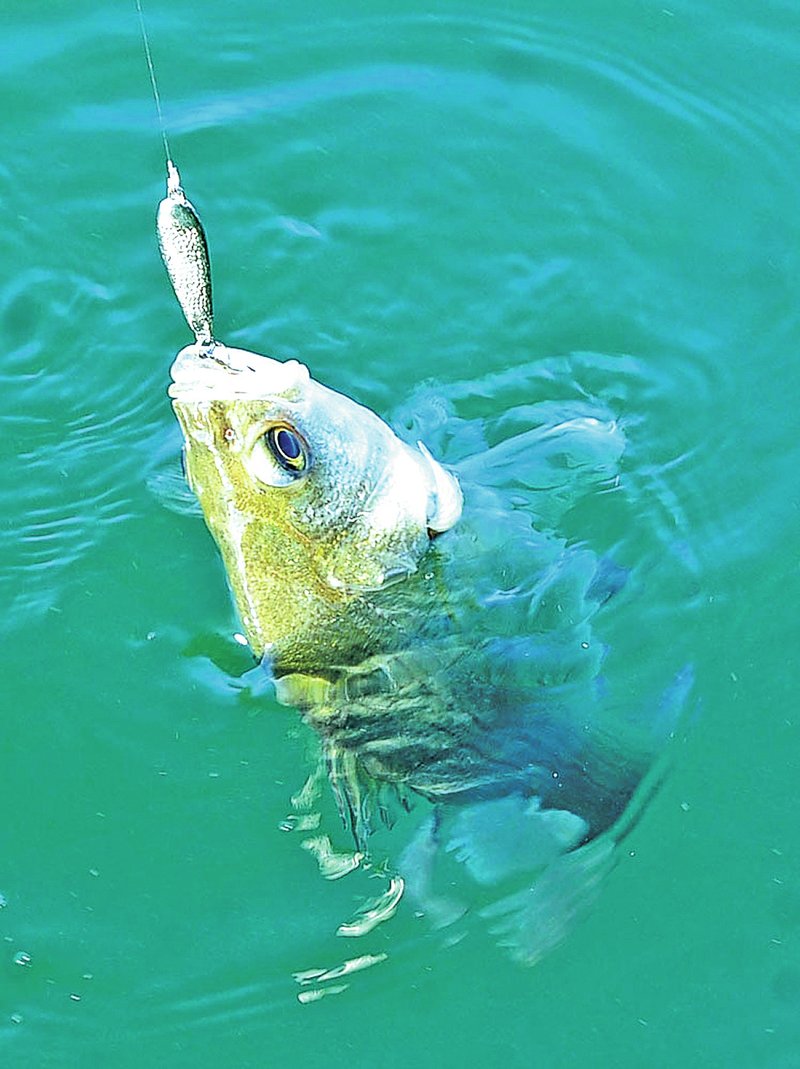ROCKY BRANCH
Summertime fishing at Beaver Lake can be like spinning a fortune wheel. Anglers never know what kind of fish they'll catch when a jigging spoon is tied to the line.
Get The Red Out
White bass filets are fine table fare. They taste best when any red meat is removed as the fish are fileted. This red meat has a strong taste most people don’t like. Striped bass and hybrid stripers also have this red meat.
Source: Staff Report
They're one of summer's hottest lures, these jigging spoons. They're simple in design and easy to use. Just lower a spoon over the side of the boat, let it sink to the bottom, then jig the spoon up and down with the rod tip.
White bass are most likely to bite a darting, dancing jigging spoon. They think it's a threadfin shad, a bait fish that all game fish at Beaver Lake eat. That's why fishermen never know what species will come calling. Walleye, catfish, striped bass, largemouth bass may all be part of a mixed-bag catch.
Jigging spoons become popular at Beaver Lake toward the end of summer. Gravel areas are the top spots. Gravel points, flats and bays are all worth a try. A depth finder is handy to show if there are fish in the area, but it isn't a required tool.
Fishermen can hop from point to point, probing each one with a jigging spoon.
Better get out early. Action is best from first light until midmorning in this fortune-wheel fishing.
One Lure, All Species
We'd been doing well all month with jigging spoons worked over the many gravel points in the Rocky Branch area. The hot spot was a nondescript bay shaped like half moon that no one else fished.
We sacked up a mess of white bass from this bay on Aug. 4 and I had to share the joy with Jon Stein. He's the regional fisheries biologist with the Arkansas Game & Fish Commission and manages the fishery at Beaver Lake. Stein and I hit the water last Thursday morning to see if the fish would still bite.
It was "carpe diem" the minute our jigging spoons hit the water. The day's first fish bit my white and chartreuse War Eagle brand jigging spoon. The fight was a dogged one until a 5-pound carp showed itself at the side of the boat.
The spoon was solidly hooked to the carp's leathery lip so the fish must have bit it. It wasn't foul hooked. We admired the bug-eyed carp and slid it back into the drink.
That carp was like the warm-up band at a big concert. White bass were the headliners we came to see and catch. These silvery fighters wasted no time attacking our spoons, as long as we fished them near the bottom.
Stein boated a trio of fine-sized white bass, then caught a 4-pound channel catfish for good measure. We each reeled in a passel of small-sized striped bass that we threw back. Stripers must be 20 inches or longer to keep at Beaver Lake.
We could almost predict when the fish would bite by watching the depth finder. Almost every time the screen showed fish, we'd catch 'em. At times the screen image was bare bottom and no fish. Then the sonar would show a school and it was game on. The magic depth was 25 to 35 feet.
We called it a morning about 10 a.m. Our catch list included carp, catfish, striped bass, spotted bass and white bass.
We practice catch and release with a lot of our fishing, but when the white bass bite, we go for the "Three Cs" -- catch, clean and cook.
There's no limit on white bass at Beaver Lake or it's tributaries. These are the only Arkansas waters with no daily limit on white bass. Stein was happy to explain the reason for this no-limit fishing.
Feeding Frenzy
For one thing, Beaver Lake is loaded with white bass. They're prolific spawners, especially if the lake level is high at spawning time. Adults produce millions of young, Stein explained.
White bass that grow into adults eat a tremendous amount of threadfin shad, which are the main forage for all game fish at Beaver. When fishermen take lots of white bass out of the lake, it's good for the shad population.
White bass grow quickly, but they don't live long, Stein said. A typical white might be 6 inches long when it's a year old, 10 to 12 inches long at age 2. They only live 6 or 7 years.
There may be no limit, but Stein said it's rare for anglers to keep high numbers of white bass. Even if the daily limit was, say, 25, hardly anyone keeps 25 white bass, he said.
A minor downside to the no-limit, he said, is that someone may keep a bunch of whites, get tired of cleaning them and throw the rest in a ditch.
Half-Moon Bay
Stein and I caught our mixed bag mostly from the same place, a bay shaped like a big half moon. We never saw another boat near the bay all morning.
"I wouldn't have thought of fishing here. I would've looked for a point or something," Stein said.
We tried two other spots, both points. The catching was good at one point but we got blanked at the other.
Summer is the season to spin that fishing fortune wheel at Beaver Lake. Find a point, lower a jigging spoon and hang on.
Outdoors on 08/21/2014

